UNDP – B&H
Study of Economic Impacts of Climate Change on the Hydropower Sector in the Republika Srpska – the Trebisnjica Multipurpose Hydropower System
(Energoprojekt – Hidroinzenjering, Belgrade & Institute for Water Management, Bijeljina, 2019-2020)
Within this study we carried out basic hydrological analyses for reference profiles of hydropower facilities (existing and planned), followed by detailed hydrological analyses of the impact of climate change in the area of the Trebisnjica Hydrosystem (including data available at the end of 2018). We calculated possible production of existing and planned hydroelectric power stations (Figure 1) in climate change scenarios and economic impacts of climate change on these hydropower facilities.
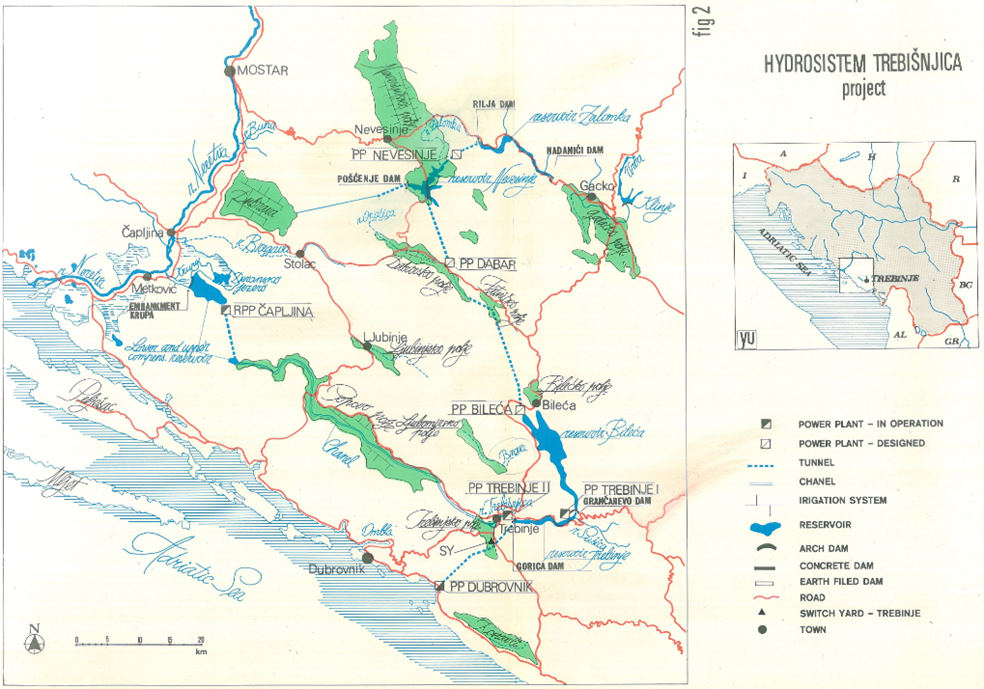
Given the sensitivity of the hydropower sector to changes in available water, we assessed the parameters of the hydrological balance following a strict procedure for identification, calibration and verification of the model.
-
-
- The 30-year period 1961-1990 was selected for identification, which is also a valid reference period of the World Meteorological Organization (WMO).
-
The identification and calibration of RCM was carried out by adjusting the distribution of precipitation determined at individual locations with measurements and distributions of 9 regional climate models.
-
-
- The last (latest) period with measurement data from 2006 to 2018 (13 years) was selected for verification.
-
During the verification, the median of the model ensemble was determined on the basis of individual results from 9 models.
-
-
- Forecasts included the following two time frames:
- Near future (30-year period from 2021 to 2050); and
- The distant future until the end of the 21st century (50-year period from 2051 to 2100).
-
Forecasts were also made through the ensemble median and using the results of 9 individual regional models based on forecasted daily precipitation. Combining the results of multiple models into an ensemble (instead of adopting just one model) has two benefits:
-
-
- It is proved that and ensemble median gives a more probable projection of the future state than any individual model;
- Using the results of an ensemble of several models clarifies the uncertainty of results and gives a range of possible (expected) values of the parameters to be observed in the future.
-
In the verification phase, based on precipitation measurement data at 18 locations (at 13 rain gauge stations; 5 could not be included because by the end of this part of the study the coordinates of the stations were not submitted), relative errors ranged from -21.7% to +3.5 % with an average RE = -7.1%.
Forecasts for the near future (2021-2050) compared to the reference period 1961-1990 predicted precipitation increases at 28 locations ranging from 3.8% to 17.1% with an average RR = 9.1%.
A similar result was obtained for the forecasts of the distant future (2021-2050). Precipitation increases at 28 locations are expected to range from 3.7% to 17.0% with an average RR = 9.2%.
We carried out energy analyses, i.e. electricity generation by the existing and planned hydroelectric power stations, taking into account the needs of other users (water supply, irrigation, and environmental flow).
We analysed prospective areas according to the Water Permit from 1962 and established that this area is lower by 26.15%, i.e., that there is a need to irrigate a total of 8,736ha (the RS, FB&H and Croatia) from multipurpose reservoirs of the Trebisnjica Hydropower System (Figure 2). We also analysed the real needs in the current state (Water Permit No. 12/8.05..2-4848-2/18 of 16.10.2018 for the Trebinje I HPP) where a total of Vn=44.7x106m3 is required as an annual volume for irrigation for a hypthetical dry year.
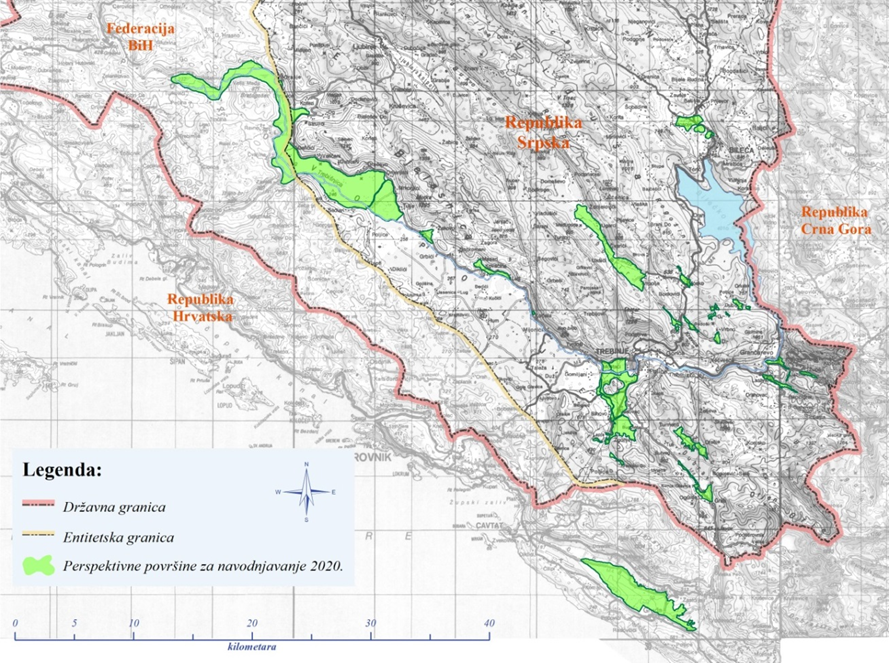
The following conclusions are made on the basis of hydrological and energy analyses:
-
- There is an impact of climate change on expected air temperature and precipitation levels in the future;
- There are also impacts of precipitation and increased air temperatures on the flow levels. The impacts of increased temperatures are manifested by an increase in evaporation from the reservoir surfaces, while the impacts of precipitation are manifested in two ways:
o Impact on entire drainage basin; and
o Direct impact on the reservoir surface.
-
- In the water balance of the reservoir, the impacts of evaporation and direct precipitation have opposite effects. The effects of direct precipitation are greater than the effects of evaporation, and the total effects of evaporation and direct precipitation in the reservoir are less than 1% of the inflow;
- The effects of the increase in flows in the near and distant future are almost the same (9.1% and 9.2%);
- The impact of climate change on the level of hydroelectric power stations production is mainly defined by the expected increase in flows.
- The energy effect of climate change on the possible production of hydroelectric power stations, defined by the difference in production in the near future and the reference period, is proportional to the increase in flow;
- Differences in relative increments of possible production and flow are due to the energy characteristics of hydroelectric power stations and the position in the basin;
- Evaporation from reservoirs and direct precipitation into reservoirs practically have no impact on the energy effects of climate change;
- The total level of energy effects, as a consequence of climate change, in the Trebisnjica basin is positive and amounts to 252 GWh, while the impact of climate change on the available power of hydroelectric power stations does not exist;
- There is a clear technological interest in the further development of the hydropower system in the Trebisnjica basin and, in that sense, a logical order of construction of facilities.
- Technologically, there is a logical method for managing such a system based on the unique interest of profit maximization.
According to the RS Energy Development Strategy until 2030, energy is a strategic sector for the development of the overall RS economy. The RS has a great potential for the development of this area, primarily in terms of significant and insufficiently used hydropower potential. The total technically usable hydropower potential of the RS is 3,351.69 MW of installed capacity and 9,962.66 GWh of average annual electricity generation. The Trebisnjica basin accounts for almost a quarter of the total technical potential. In the current state, about 2,985.8 GWh/year is used, which is 30% of the total potential.
The European Commission presented a comprehensive ‘European Green Deal’, with the goal of making Europe the first climate-neutral continent by 2050. The essence is in a new growth strategy that should reduce CO2 emissions by as much as 50-55% by 2030, while creating jobs and improving the quality of life. For that purpose, it is planned to invest one billion euros in the next decade, while the European Investment Bank committed to become a European climate bank. Investments are related to increasing the capacity of RES. Many countries have used their hydropower potential, and, in light of the decisions made, they are more concerned with wind and solar power stations. Biomass power stations are almost no longer considered a renewable energy source. All of this makes the untapped hydropower potential of the Republika Srpska even more important.
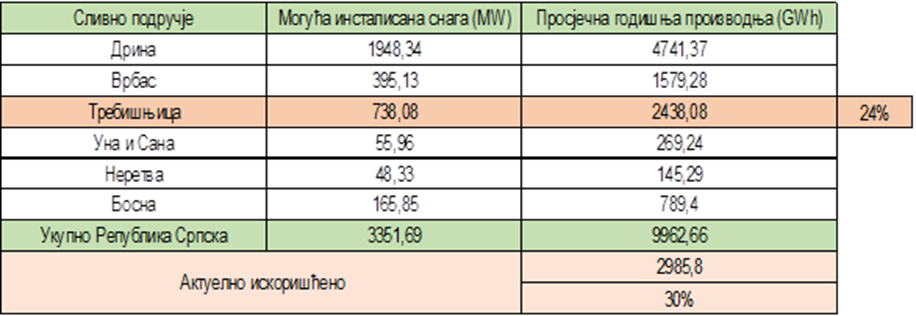
According to the electricity generation plan for 2020, the total planned production of electricity for 2020 is 8,028.17 GWh, of which thermal power stations will produce 5,200 GWh (65.26%), hydroelectric power stations 2,352.67 GWh (29.53%), and all small power stations 415.45 GWh (5.21%). According to the planned electricity generation, the net actual generation of hydroelectric power stations in 2020 is 2,352.67 GWh. Of this, HET accounts for 1,108.07 GWh, which is 47.1% of the total planned generation from HPSs.
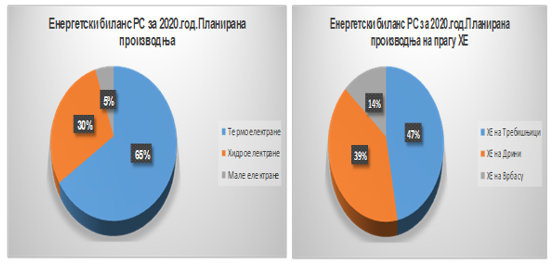
Electricity production is higher than consumption, and the budgeted surplus planned for 2020 is 47% of the total electricity produced (3,787.72 GWh).
In the light of such dimensioned power supply system, an assessment of the potential impact of climate change on the actual production of the existing facilities, and specifically planned facilities, can assist decision makers with regard to the management of the existing facilities and timeline of investing in planned facilities. The problem of managing ‘HET’ is more complex, because of the issue of multipurpose use of the existing reservoirs (Bileca and Trebinje) and planned reservoirs (Zalomka), as well as the fact that facilities and users are located in two countries and three entities (RS, RC, FB&H).
The basis for the economic evaluation of the effects of climate change are the calculations given in the energy analyses, as well as additional calculations taking into account the effects of the Trebinje 2 HPS, the impact of Dubrovnik 2 HPS on Trebinje 1 HPS, different ways of using the Bileca reservoir, etc. The issue of flood flows and flood defense was not considered, and, therefore, their impact on the levels in the reservoir is not included. The needs of other priority users of water and space (water supply, irrigation and environmental flow) are taken into account according to available data.
Within the economic evaluation, we considered scenarios of the climate change effects on the existing facilities (Trebinje 1 HPS with the Bileca reservoir, Dubrovnik 1 HPS with the Trebinje reservoir, Trebinje 2 HPS with the Trebinje reservoir, and Dabar HPS) and on the future facilities (Dubrovnik 2 HPS, Bileca HPS and Nevesinje HPS). Given that the construction of the Dabar HPS is well under way, this study assumed a completed power station.
The period 1961-1990 was selected the basic reference state, which was used for observation of impacts, while the near future period 2021-2050 was taken as the period in which the impact of climate change on the level and structure of possible production was observed. The table below shows the results for existing facilities.
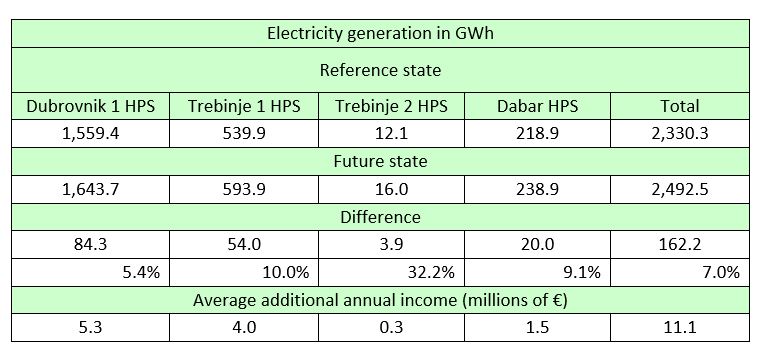
Therefore, it was assessed that climate change will have a positive impact in the near future period on the level of average annual production compared to the reference state (162.2 GWh), i.e. an increase in average production of 7% per year. Based on sale prices at the Hungarian Stock Exchange and assuming operation of HPSs for maximum profit, an average annual additional income of € 11.1 million is generated. The table below shows the results of the economic assessment of the impact of climate change for the planned facilities in the near future period.
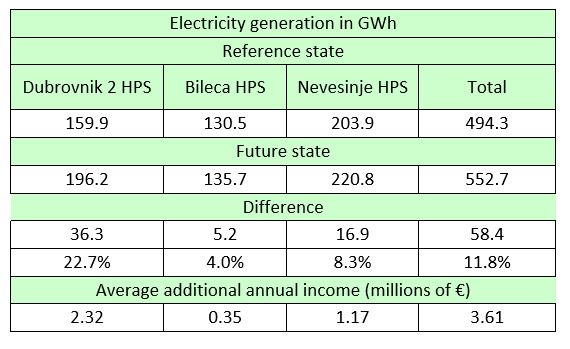
It is important to note that the effects of the planned facilities also include knock-on effects at the existing facilities. This primarily refers to the effect of the construction of the Nevesinje HPS in terms of the transfer of Gatacka waters and the impact on increasing production at Dabar and Bileca HPSs. The evaluation of the effects of the Dubrovnik 2 HPS also includes the effects on the Trebinje 1 and 2 HPSs, in terms of increasing or decreasing production, better quality work (redistribution of energy in terms of quality of the existing Dubrovnik 1 HPS), which implies an increase in average annual income. Climate change impact in the near future period on the production effects of the planned facilities was assessed as positive, i.e. an increase in average annual production of 58.4 GWh. This is an increase of 11.8% compared to the reference state, which consequently led to an increase in average annual income by €3.61 million
The results of the dynamic estimation method (by applying discounted cash flow method to costs and revenues) are expressed through the following indicators: economic cost (average additional discounted electricity costs), internal rate of return (IRR), and net present value of the project (NPV). All economic indicators are calculated regardless of the project financing conditions. Calculations were made for discount rates ranging from 4% to 10%. The results shown in tables below are calculated with a 4% discount rate.
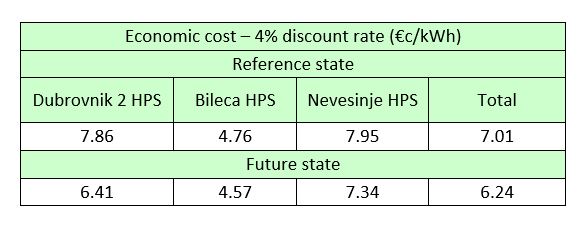
The impact of climate change is most pronounced on the Dubrovnik 2 HPS in terms of reducing the economic cost by 18.5% compared to the reference state. Observed in total for all planned facilities, it was estimated that the reduction of the economic cost of an average produced kWh is 10.9% in relation to the reference state. The economic cost shows us what an average selling price should be to cover all capital and operating expenditures and, at the same time, to achieve the rate of return on invested funds in the amount of the applied discount rate. In this light, any reduction in economic cost increases the financial feasibility of the project.
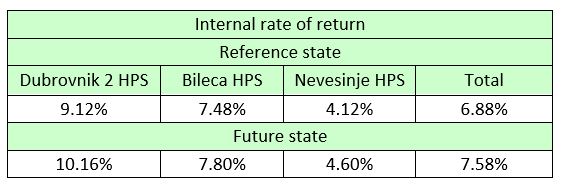

In addition to the evident positive impact of climate change, the indicators of internal rate of return and net present value of investment for planned facilities resurrects the issue of constructing the Nevesinje HPS with the Zalomka reservoir with normal water surface at 970m. Economic feasibility of this multipurpose facility (primarily water management facility) is given in the project ‘Update and Amendment of the Preliminary Design of the Nevesinje HPS with a Feasibility Study’ (Energoprojekt-Hidroinzenjering, 2018). In addition to the energy effects, this project also included the effects of irrigation and water supply. Therefore, from the financial aspect of feasibility, the question is whether energy industry, as a secondary user, should pay the entire investment cost on its own.
Observed both for existing and planned hydroelectric power facilities in the Trebisnjica basin, the effect of climate change in the near future was assessed as positive in terms of increasing average annual production by 220.6 GWh, which is an increase of 7.8% compared to the reference state (from the aspect of energy supply, and respecting the needs of water supply as the priority user). The increase in flow and production will cause a growth of the average annual income, which, valued with the current market-stock prices, is by €14.9 million. Having in mind the fixed character of capital and almost all operating expenditures, additional income can be conditionally considered as an added business profit in case of hydroelectric power facilities, which will reflect on the profitability and liquidity of existing and planned facilities.
In addition to supplying required electricity and power, hydroelectric power stations in the Trebisnjica basin can also provide cold reserve for the power supply system or stock exchange. In the current situation, there is a surplus of production capacity in the region, resulting in low price of system services. In addition, there is no market that offers cold reserve today. Given that all power companies in Europe are to a significant extent switching to systems of renewable sources (characterized by great unavailability of primary energy source), which is accepted by all countries to reduce the greenhouse effect, the issue of reserve capacity will be further aggravated. The issue of covering the longer absence of primary energy source in renewable energy sources will be especially aggravated. This will generate the need for longer engagement of the reserve, requiring the availability of energy in addition to the availability of power. Hydroelectric power stations in the Trebisnjica basin can provide these needs to a significant extent.
The effects of climate change on the hydroelectric power stations on the Trebisnjica are expressed in the additional produced energy. The effects in terms of providing system services and increasing power and quality of energy produced depend solely on the construction of the planned systems and are not subject to the impact of climate change.


